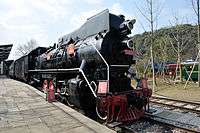China Railways JS
|
JS 5001 at the Beijing Railway Museum | |||||||||||||||||||||||||||||||||||
| |||||||||||||||||||||||||||||||||||
| |||||||||||||||||||||||||||||||||||
| |||||||||||||||||||||||||||||||||||
| Sources:[4][5] except where noted | |||||||||||||||||||||||||||||||||||
The China railways JS class (Chinese: 建设; pinyin: Jiàn Shè; literally: "Construction or Development") was a type of 2-8-2 tender steam locomotive manufactured for use on mainline freight trains, as well as for heavy shunting.
History
The JS class was developed at the Dalian locomotive works;[4] the design used the chassis design of the China Railways JF class, with a new boiler type.,[3][6] The first locomotive was produced in 1957; subsequently Dalian work and Qishuyan Locomotive and Rolling Stock Works produced over 1000 of the class, Datong locomotive works, and the Beijing 7th Feb works also manufactured vehicles.[4] By 1965 1,135 vehicles had been made.[5]
A second production phase began in 1981; Datong produced 358 locomotives by 1986. In 1986 a revised 'B' specification was introduced, and 434 units of this type were made; construction ended in 1988.[3] the second tranche of locomotives received numbers from 8001 upwards. By the end of production 1916 units have been produced of both series combined.[1][2][3]
In the late 1980s the Boone and Scenic Valley Railroad of Iowa, USA bought a JS type locomotive for $355,000, number JS-8419.[7]
Numbering
Locomotives produced from 1957 to 1965 were numbered JS-5001 to JS-6135. Starting at 5001 avoided overlapping the numbers of the various types of JF occupying the 1 - 4100 (approx) range. Locomotives produced at Datong in the early 1980s were numbered JS-6201 to JS-6558; after the introduction of the revised 'B' specification the locomotives were numbered JS-8001 to JS-8423. A small number of locomotives operating outside the scope of the ministry of railways (industrial railways) received different number designations.[3]
Gallery
- Boone and Scenic Valley Railroad's JS-8419
.jpg) JS-5151
JS-5151 JS-1953 in Central South University
JS-1953 in Central South University JS-8376 in Liuzhou Locomotive Depot
JS-8376 in Liuzhou Locomotive Depot Hangzhou Baita Park's JS-8347
Hangzhou Baita Park's JS-8347
Preservation
5000 Series
.jpg)
- JS-5001: is preserved at the China Railway Museum[8]
- JS-5003: is preserved at Shenyang Railway Museum
- JS-5039: is preserved at Beijing Exhibition Center
- JS-5301: is preserved at Taiyuan Locomotive Depot, Taiyuan Railway Bureau
- JS-5342: is preserved at Weifang Railway Station
6000 Series
- JS-6023: is preserved at China Tiesiju Civil Engineering Group Co.,Ltd
- JS-6244: is preserved at Nanchang Fenghuangzhou Park(Now renamed JS-6289)
- JS-6499: is preserved at Hainan Railway Museum
- JS-6532: is preserved at Nanjing Railway Vacational Technical College
- JS-6533: is preserved at Shandong Architecture University(Now renamed JS-5610)
8000 Series

- JS-8010: is preserved at Central South University(Now renamed JS-1953)
- JS-8024: is preserved at Jinhua Vocational Technical College
- JS-8077: is preserved at Zhengzhou Century Amusement Park(Now renamed JS-8001)
- JS-8145: is preserved at Xuhui Riverside Park, Shanghai
- JS-8239: is preserved at Gongchangling Iron, Liaoyang
- JS-8260: is preserved at Songhu Railway's Jiangwan Station Former Site, Shanghai
- JS-8284: is preserved at Liuzhou Railway Vacational Technical College[9]
- JS-8297: is preserved at Nanxiang Power Locomotive Maintenance Base, Shanghai Railway Bureau
- JS-8316: is preserved at Yuanzhou District NO.6 Middle School, Guyuan
- JS-8325: is preserved at Tianjin Railway Vacational Technical College
- JS-8328: is preserved at Southwest Jiaotong University[10]
- JS-8343: is preserved at Yantai Railway Station
- JS-8347: is preserved at Hangzhou Baita Park
- JS-8376: is preserved at Liuzhou Locomotive Depot, Nanning Railway Bureau(Now renamed JS-1939)[11]
- JS-8401: is preserved at Hangzhou Jiangshu Railway Heritage Park
- JS-8406: is preserved at Hangzhou Paradise
- JS-8422: is preserved at Tianjin Binhai Xinjiayuan Railway Cultural Recreation Street[12]
References
| Wikimedia Commons has media related to China Railways JS. |
- 1 2 3 新中国制造的蒸汽机车, www.kepu.net (in Chinese)
- 1 2 "建设(JS)型5001号蒸汽机车" ['Construction' class steam locomotive, JS-5001], www.china.com.cn (in Chinese)
- 1 2 3 4 5 Duncan Cotterill, "JS Class 2-8-2", Railography
- 1 2 3 4 建设型蒸汽机车 [Construction type steam locomotive], www.zztl.com (in Chinese), archived from the original on 23 December 2008
- 1 2 Sources:
- 建設型煤水車式蒸汽機車, www.kurogane-rail.jp (in Chinese)
- "JS(建設)形蒸気機関車", www.kurogane-rail.jp (in Japanese)
- ↑ Duncan Cotterill, "JF Class 2-8-2", www.railography.co.uk
- ↑ 在美國的中國建設型蒸汽機車 [Construction class steam locomotive in the USA], www.readingtimes.com.tw (in Chinese)
- ↑ "建设(JS)型5001号蒸汽机车" [Construction class steam locomotive, JS-5001], www.china-rail.org (in Chinese), China Railway Museum
- 1 2 Sources:
- 第一代机车入驻柳铁职院校园 营造铁路文化氛围, news.gxnews.com.cn (in Chinese)
- "南宁铁路局与柳州铁道职业技术学院进行校企合作、产教融合。路局将退役的一台蒸汽机车捐赠给学校,创建浓厚铁路文化", weibo.com (in Chinese)
- ↑ "国内首个高校机车博物园 在西南交大开园", scnews.newssc.org (in Chinese)
- ↑ Sources:
- 柳州机务段一台“建设型”蒸汽机车,以崭新的面貌矗立在锅炉房的一侧,倍受职工的关注,形成我段传统教育的一个景点, weibo.com (in Chinese)
- "柳州机务段"镇段之宝"蒸汽机车小别"宝座"两天后,经过21次重复的作业,终于昂首挺胸的回到自己的"宝座"。", weibo.com (in Chinese)
- ↑ "火车文化博物馆滨海欣嘉园火车文化休闲街开放", www.tianjinwe.com (in Chinese)
